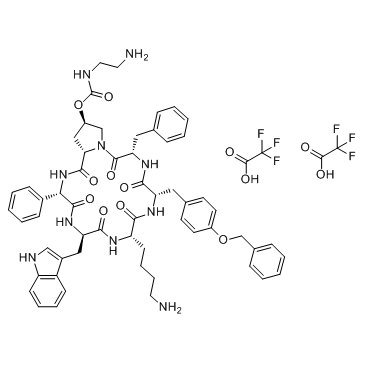Pasireotide ditrifluoroacetate |
| Catalog No.GC36857 |
Le ditrifluoroacétate de pasiréotide (SOM230), un analogue de la somatostatine cyclohexapeptide À action prolongée, peut améliorer l'activité agoniste des récepteurs de la somatostatine (sous-types sst1/2/3/4/5, pKi=8,2/9,0/9,1/<7,0/9,9, respectivement).
Products are for research use only. Not for human use. We do not sell to patients.

Sample solution is provided at 25 µL, 10mM.
Pasireotide (ditrifluoroacetate) is a stable cyclohexapeptide somatostatin mimic that exhibits unique high-affinity binding to human somatostatin receptors (subtypes sst1/2/3/4/5, pKi=8.2/9.0/9.1/<7.0/9.9, respectively). pKi: 8.2 (sst1), 9.0 (sst2), 9.1 (sst3), <7.0 (sst4), 9.9 (sst5)
Pasireotide effectively inhibits the growth hormone releasing hormone (GHRH) induced growth hormone (GH) release in primary cultures of rat pituitary cells with an IC50 of 0.4±0.1 nM[1].
Pasireotide potently suppressess GH secretion in rats. The ED50 values determined at 1 and 6 h after injection of pasireotide indicates its very long duration of action in vivo. In the rat, pasireotide strongly decreases IGF-1 plasma levels, with the efficacy being markedly enhanced compared with the effects elicited by SMS 201-995 after 7 days of treatment. Furthermore, in rats, dogs, and rhesus monkeys, pasireotide potently and dose-dependently decreases IGF-1 levels for prolonged periods of time without desensitization[1]. Pasireotide (160 mg/kg/month, s.c.) decreases serum insulin levels and increases serum glucose levels, reduces PNET tumor size, and demonstrates a reduction in tumor activity on PET/CT scan in Pdx1-Cre; Men1 floxed/floxed conditional knockout mice[2]. Pasireotide (50 μg/kg) inhibits arthritic joint swelling in a dose-dependent manner, strongly inhibits joint swelling during the acute phase of AIA. Pasireotide- and octreotide-treated mice show significantly increased mechanical thresholds on the inflamed side. Pasireotide potently decreases secondary hyperalgesia to mechanical and thermal stimuli. Mechanical thresholds in the pasireotide-treated mice are significantly higher than those in the saline-treated or octreotide-treated animals[3].
[1]. Lewis I, et al. A novel somatostatin mimic with broad somatotropin release inhibitory factor receptor binding and superior therapeutic potential. J Med Chem. 2003 Jun 5;46(12):2334-44. [2]. Quinn TJ, et al. Pasireotide (SOM230) is effective for the treatment of pancreatic neuroendocrine tumors (PNETs) in a multiple endocrine neoplasia type 1 (MEN1) conditional knockout mouse model. Surgery. 2012 Dec;152(6):1068-77. [3]. Imhof AK, et al. Differential antiinflammatory and antinociceptive effects of the somatostatin analogs octreotide and pasireotide in a mouse model of immune-mediated arthritis. Arthritis Rheum. 2011 Aug;63(8):2352-62. [4]. Lorenzo Pisarello M, et al. The combination of an HDAC6 inhibitor and a somatostatin receptor agonist synergistically reduces hepato-renal cystogenesis in an animal model of polycystic liver disease. Am J Pathol. 2018 Apr;188(4):981-994.
Average Rating: 5 (Based on Reviews and 38 reference(s) in Google Scholar.)
GLPBIO products are for RESEARCH USE ONLY. Please make sure your review or question is research based.
Required fields are marked with *




















